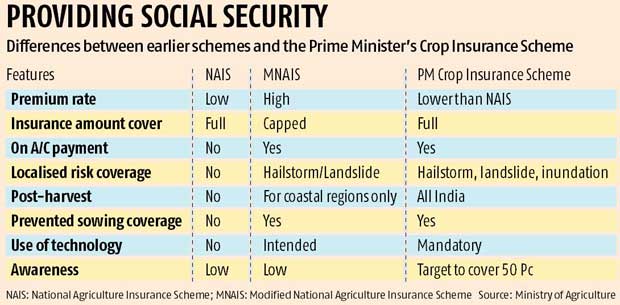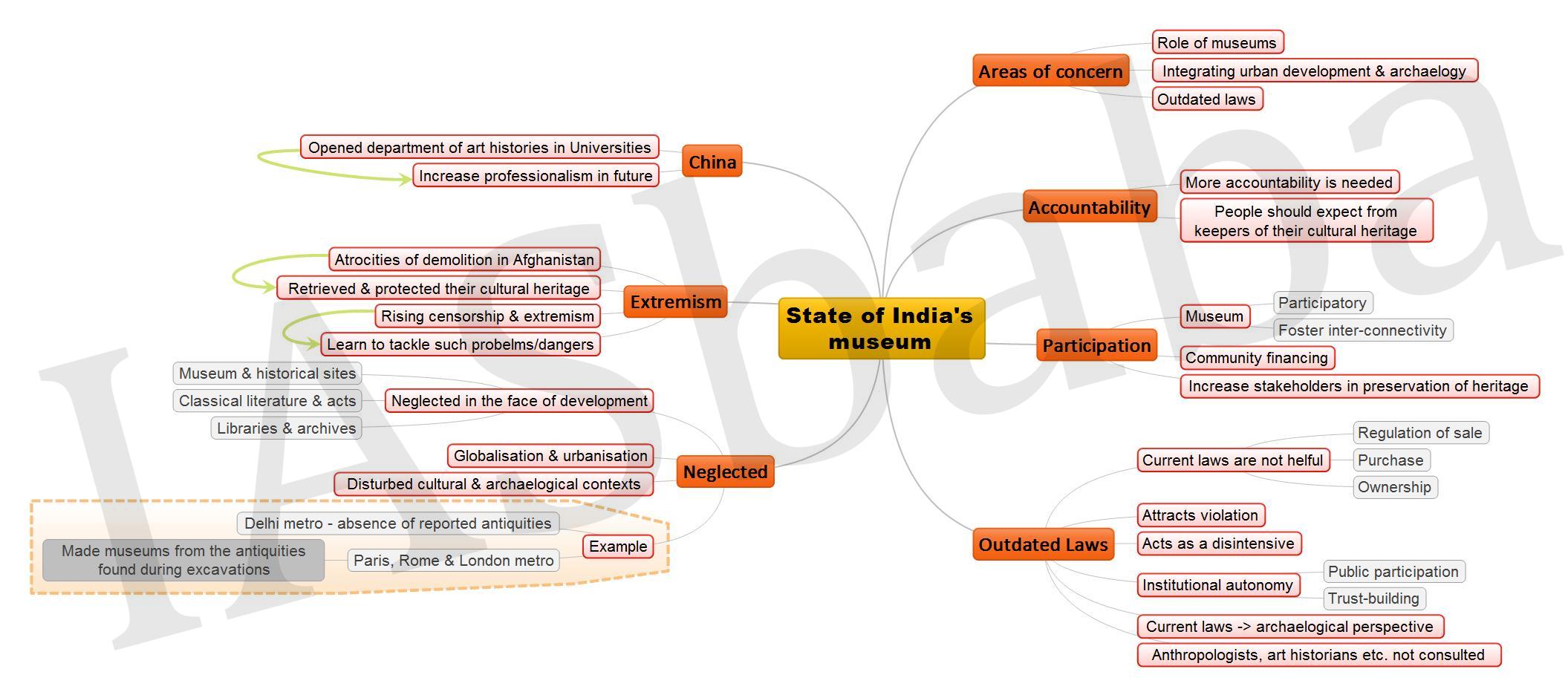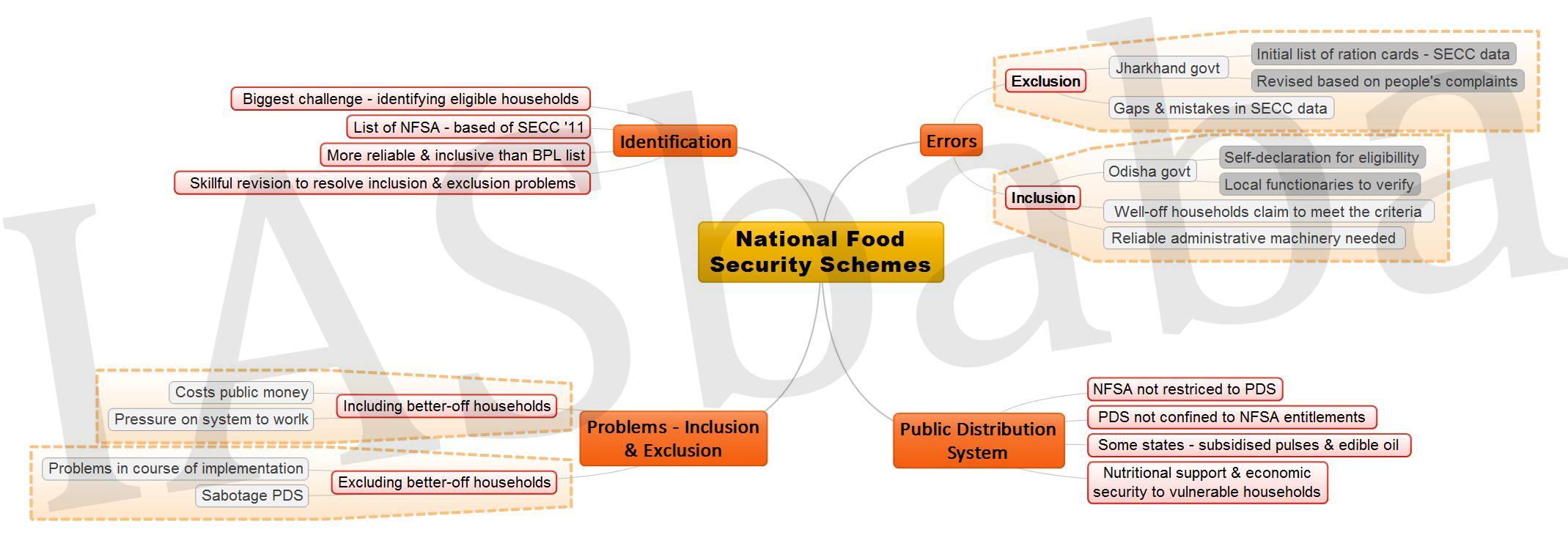IASbaba's Daily Current Affairs Analysis, IASbaba's Daily Current Affairs January 2016, National, UPSC
Archives
IASbaba’s Daily Current Affairs – 14th January, 2016
ECONOMICS
TOPIC:
General studies 2:
- Government policies and interventions for development in various sectors and issues arising out of their design and implementation.
- Welfare schemes for vulnerable sections of the population by the Centre and States and the performance of these schemes; mechanisms, laws, institutions and Bodies constituted for the protection and betterment of these vulnerable sections.
General studies 3:
- Major crops cropping patterns in various parts of the country, different types of irrigation and irrigation systems storage, transport and marketing of agricultural produce and issues and related constraints; e-technology in the aid of farmers.
Insuring a risky venture called agriculture
- In a bid to provide a social security net to millions of farmers across the country, reeling under the impact of consecutive droughts, the Union Cabinet has approved a new crop insurance scheme called Pradhan Mantri Fasal Bima Yojana (Prime Minister’s Crop Insurance Scheme).
What is the scheme all about?
- The scheme provides agricultural insurance for crops against crop loss and failure.
- It will charge a uniform premium of two per cent of the sum insured from farmers for all kharif crops and 1.5 per cent for rabi crops.
- For horticulture crops, the annual premium will be five per cent of the sum insured.
- The balance premium would be paid by the government to the insurance companies.
- This would be shared equally by the Centre and state governments.
Comparing with earlier agriculture insurance schemes:

Advantages of the new scheme:
- The scheme has the lowest premium, it entails easy usage of technology like mobile phone, quick assessment of damage and disbursement within a time-frame.
- For the Centre, there would be no upper limit on the subsidy and even if the balance premium is 90 per cent, it would provide for the same.
This also means if a state government does not fulfil its commitment of 50 per cent subsidy sharing, the Centre would step in but not allow the scheme to fail.
Low premium rates: uniqueness of the scheme
- Till now, the average premium for all food grain crops was as high as 15 per cent, while for horticulture crops, it was even higher.
- However the premium rates in the new scheme would as low as 2% for kharif crops, 1.5% for rabi crops and 5% for horticultural crops.
Practical problem associated with earlier agriculture insurance schemes:
There have been many crop insurance schemes in the past, but all of them have some problem or the other.
Which is why the total crop insurance cover till now in agriculture is 23 per cent.
Under the earlier schemes, according to rules, farmers’ insurance claims have to be settled within 45 days of the risk assessment. However, often, claims are not attended to even after six months, which is a major reason why farmers don’t for crop insurance.
Fundamental problem of Indian agriculture:
- The fundamental problem with Indian agriculture is that farmers face yield risks as much as they face price risks.
- No other sector can claim this level of uncertainty at almost every level of operation—
- The risk of monsoon failure and infestations during crop growth,
- The risk of lower prices after harvest,
- Compromise in quantity and quality during storage and distribution etc.
These risks assume higher proportions given productivity and technology lacunae and affects the economy as a whole through the agriculture sector’s extensive linkages.
How much will the scheme cost the government?
- The new insurance scheme would cost the government Rs 8,800 crore over the next three years, assuming that 50 per cent of farmers are covered.
- At present, with 23 per cent insurance cover, the Centre spends Rs 3,100 crore a year on crop insurance.
- The insurance amount covered will also not be capped and so also the premium rates.
Way ahead:
- The new crop insurance scheme is a well-timed policy.
- However attempts were made in the past to insure the Indian crop market, and almost all of them have failed.
- Critical implementation gaps that led to failure of previous schemes should be studied and reworked upon in order to make the new scheme successful.
Connecting the dots:
- Critically examine the factors that impact agricultural productivity in India, explain with special reference to impact of agriculture insurance.
- Even though more than 60% of total arable area in India is dependent on monsoons for crop production, the agriculture crop insurance coverage is less than 25%. Explain the reasons for low crop insurance penetration among farming community in India along with measures taken by government to promote agricultural insurance.
NATIONAL
TOPIC:
- General studies 1: Role of women and women’s organization, Effects of globalization on Indian society, Social empowerment
- General studies 2: Welfare schemes for vulnerable sections of the population by the Centre and States and the performance of these schemes; mechanisms, laws, institutions and Bodies constituted for the protection and betterment of these vulnerable sections; Issues relating to development and management of Social Sector or Services relating to Health, Education, Human Resources.
Women at Work
- The Central government’s move to ensure adequate maternity protection has welcomed a happy response especially when India stands out in the world owing to its shocking low rates of recognised work participation (24%) that has gone on to only decline.
- This is not only a huge economic loss but is a sign of ‘low status’ being continuously accorded to women as well as the lack of agency to correct it in the country
Observations by MCKINSEY
- The world can add $12 trillion to GDP in 2025, doubling the contribution of women to global growth in business-as-usual scenario in the coming decade. India could boost its GDP by $0.7 trillion in 2025 or 16 percent of the business-as-usual level (largest relative boost). This translates into 4 percent per year of incremental GDP growth for India.
- Where gender parity is set at 1.00, India’s GPS is just 0.48, lower than warranted by its stage of economic development
Unsung & Unrewarded:
- Most women in India are involved in unpaid work (home and communities)
- Official data has pointed out an increased movement of women from paid and recognised employment to doing unpaid work in their household
Factors contributing to this tendency—
- Inadequacy of Job Creation
- Gender gaps in Education
- Combination of less skilled but physically arduous job-set with low payment
- Double burden of pain and unpaid work
- Difficulty in managing domestic responsibilities (unequal division of household work)
- Patriarchal attitude within family
- Social restriction on mobility
- Concerns regarding commuting time owing to the ever-increasing atmosphere of sexual violence and rapes
Recognition & Measures
Increase in maternity Leave- From the current 12 weeks to 26 weeks
Establishments with 30 women workers or 50 total workers: Provide crèche facilities either in their premises or within half a kilometre
But there have been concerns regarding employers backing off from employing women and if they do, they would push women to adhere to informal contracts where their rights are not recognised
IASbaba’s Views:
- There definitely is good news if Indian government is trying to understand and address the issues faced by women at large as well as increase the economic participation rate of women but much need to be ensured via timely implementation and constant enforcement.
- Public intervention can bring about a real difference and therefore, it has to be wider and much ambitious.
- India has to address the issue of unpaid work—
Recognize it- Via systematic and regular time-use surveys that captures people’s activities
Reduce it- By providing more goods and services that will mitigate the need for such work
- Provisioning basic amenities- piped fuel and water
- Better quality and affordable healthcare
- Proper education- Reduce the number of female drop-outs
- Huge Gender Gap in wages& granting leadership positions
Redistribute- Between households and society and within households across males and females
Need to be Gender-Responsive
- Substitute non-market work with market-base work (lead to increase in GDP- will provide value to market-based production)
- More equitable sharing of unpaid work among men and women
- Productivity-enhancing measures for unpaid work (greater financial independence for women, and intergenerational benefits)
Connecting the Dots:
- Can these newly declared measures live up to its utility and not remain a mere tokenism of the issue? Critically examine
- ‘India’s position on gender equality is somewhat lower than its stage of economic development would warrant’. Do you agree? Substantiate
- ‘Gender equality in society with gender equality in work’— Is latter possible without the former? Discuss
MUST READ
What Free Basics did not intend to do
For Detailed Analysis on ‘Net Neutrality’ refer IASbaba’s Monthly Magazine (APRIL, 2015)
http://iasbaba.com/babas-monthly-magazine/
Related Articles:
Nothing free or basic about ‘Free Basics’ (Facebook’s initiative)
Defence Procurement: Incremental steps not enough
Farm vision statement- We need a national framework to address agricultural problems
Breaking The Terror Cycle- A full engagement with Pakistan cannot withstand major terror strikes.
Related Articles:
Save security from the establishment
Why India looks set to finally come out of the closet on Israel- 2016 is expected to be the breakout year for India’s relationship with Israel, when it is likely to finally come out of the closet
Rise and fall- Latest IIP and CPI data outlines the policy challenges that lie ahead
Digital expansion helps rich more than poor: World Bank report- Says gains of higher growth, more jobs and better public services also short of expectation, recommends more focus on access
MIND MAPS
1.State of India’s Museums
2. National Food Security Schemes















